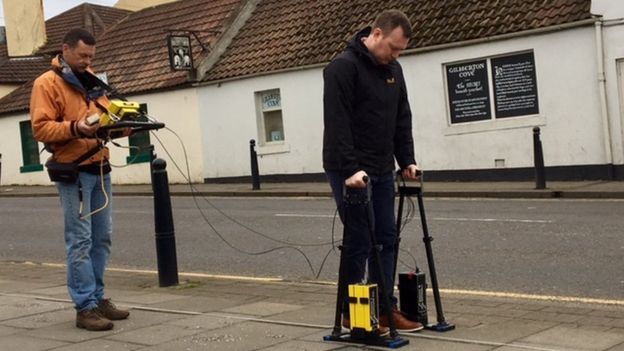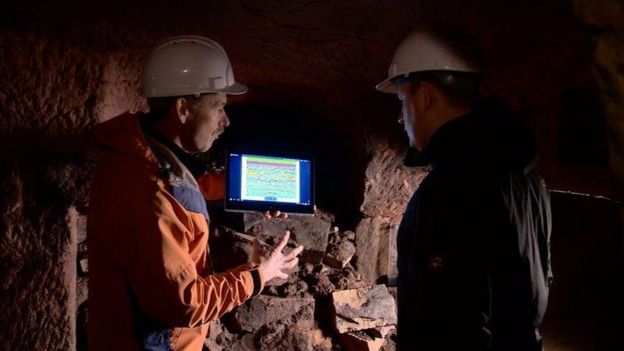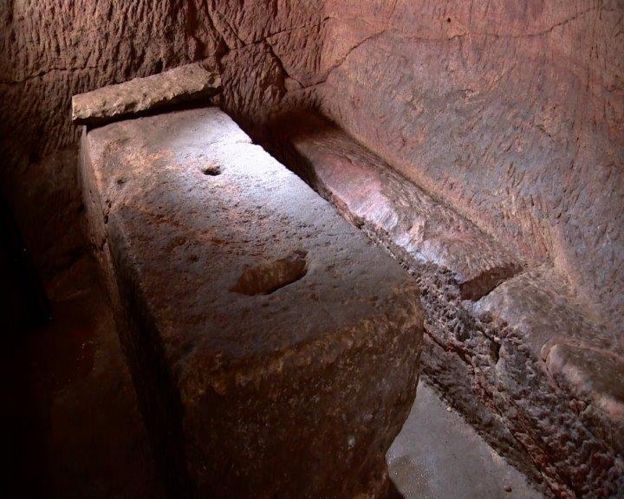Belshazzar
Ephemeral Spectre
- Joined
- Oct 8, 2003
- Messages
- 337
It's just old basements. I've seen many more exactly like them.
It's just old basements. I've seen many more exactly like them.
which was reported a couple of days before any tales of "lost streets".Gloucester House currently has 22 of its 42 offices vacant.

Well, it's only a stream, a bare trickle. And it needed reinforcing to take the weight of passing Juggernauts.Great project! I wish somethings similar could have been done with the Bodmin Leat....
I remember water lanes (I think) in Guernsey tooyou'll still see water running down roadside 'kennels'.
The link does not seem to work.An impressive underground network of tunnels and caves, curiously filled with vintage cars and forgotten World War II relics, lay forgotten under the ancient city of Naples.
http://www.bbc.com/travel/story/20161011-an-ancient-world-concealed-underground
The link does not seem to work.
The BBC link is one of those International ones which is not available in the UK.
The Via delle Memorie link has plenty of images and a general search for Galleria Borbonica will bring up lots more.
Inside Churchill's Secret Subterranean WWII Bunker in London
A new book examines the top secret wartime work underneath Whitehall.
by Anika Burgess
November 04, 2016
After the war, the Churchill War Rooms were left abandoned until 1984, when they were re-opened to the public by the Imperial War Museum. Secrets of Churchill’s War Rooms draws from personal accounts of staff, archival photographs and images of the restored rooms to provide a behind the scenes look at this once-secret space. AO has a selection of images.
Cornwall's mining history may belong in the past, but it refuses to stay there!
Road closed after mineshaft opens in St Day street
By wbchris | Posted: March 09, 2016
http://www.westbriton.co.uk/Road-cl...Day-street/story-28890711-detail/story.html#1
St Day is in an area that was heavily mined.
It's like a triumphant episode of that detectorist TV show, but without metal detectors.Man who used life savings to buy a field discovers ruins of an entire lost city under the ground
Lydia Willgress
3 January 2017 • 6:47pm
It is an unusual decision and, possibly, one that you might come to regret; using your life savings to buy an empty field.
But for one history fan it was a decision that paid off - after he dug it up and discovered it was home to a medieval city.
Stuart Wilson paid £32,000 for the 4.6-acre plot of land in 2004 after becoming convinced an ancient industrial town called Trellech - one of the largest medieval towns in Wales - may be buried underneath.
The 37-year-old had been digging in the field opposite following a tip- off from a local farmer when the land went up for auction.
He said he had looked at the area and realised it did not look typically agricultural, with large, square fields. Instead, he thought a "footprint" had been created by a structure under the ground.
After putting in the highest bid and winning the plot, the former toll booth worker had to live with his parents so he could finance the field and only managed to move back out last year.
But he said his decision was worth it, as his team have since found a moated mansion, around 400 square metres in size, and rare artefacts including a medieval flower pot.
"Out of all the decisions I have made in my life I would say buying the field was one of the good ones," he said.
"I have to say that even with all the problems that I have had or that may occur, it was definitely the right thing to do."
As well as living with his parents, Mr Wilson said he has also turned down jobs he may have otherwise applied for in order to keep working on the plot.
"I should have really bought a house and got out from my parents', but I thought: 'To hell with my parents, I will stay at home and I shall buy a field instead," he said. "People said 'you must be mad'."
Mr Wilson, who started excavating with a small dig in 2004, said the "quite large" settlement, which dates back to the 13th century, would have had a population of around 10,000 people, making it around a quarter of the size of London.
"This population grew from nothing to that size within 25 years," he said. "Now it took 250 years for London to get to 40,000 people, so we're talking a massive expansion.
"And that's just the planned settlement. The slums would have been quite numerous. There you would be talking even 20,000 plus. It's a vast area.
"If you're working in the fields you are living hand to mouth every single day - it's a really hard existence. Suddenly, a big industrial town comes here, this is a great opportunity for you.
"You up-sticks - to hell with your land - 'let's move to the industrial town where the opportunity is'."
He explained the settlement was the home of several Norman lords of the De Clare family, who used it as a place to mass produce iron.
Its precise location has not been known for hundreds of years after the city was lost to civil war and famine in the 17th century.
Archaeologists and university officials had supposedly located the industrial city near the present village of Trellech in Monmouthshire, but Mr Wilson disagreed.
"We knew from history that Trellech should have been the largest in the area," he said. "What they had found was not big enough."
In the last 15 years, Mr Wilson has been joined by hundreds of volunteers - both from the local area and, in the summer, from universities and colleges - as they unearthed what he now believes is the hidden city.
The excavation has been featured on BBC 4's Digging for Britain series, while Mr Wilson was also invited by the Cardiff Archaeological Society to speak at Cardiff University before Christmas.
Mr Wilson estimates the project has cost around £200,000 in total over the last 15 years. He is now seeking planning permission for an education centre.
He said: "As we take more on, there's a greater need to expand our campsite and while there are several campsites within a walkable distance, it would be better to have something here."
[Drone video]
http://www.telegraph.co.uk/news/201...avings-buy-field-discovers-ruins-entire-lost/
Scientists explore Edinburgh's mystery cave network
By Fiona StalkerBBC Scotland reporter
- 6 hours ago
- From the sectionEdinburgh, Fife & East Scotland
Media captionNew light shed on Gilmerton underground tunnels
New light is being shed on a mysterious network of tunnels and caves carved out of rock underneath Edinburgh.
Scientists using radar imaging equipment have discovered the ancient passageways at "Gilmerton Cove" extend much further than originally thought.
More chambers have also been uncovered during the research project, BBC Scotland has learned.
They caves lie under the former mining village of Gilmerton in the south of Edinburgh.
Druids and witchcraft
Experts have long been baffled by the origins of the underground passageways and chambers.
They include stone benches, tables and even a small chapel hand-carved out of the sandstone.
The network has been linked to druids, witchcraft, a gentlemen's drinking den and even Mary Queen of Scots.

Image captionGround penetrating radar equipment is being used to unlock ancient secrets
Now scientists from the universities of St Andrews and Edinburgh are using ground-penetrating radar equipment to map out what else may lie beneath.
The waves bounce off cavities or tunnels carved into the rock below.
The team has discovered that the subterranean network is at least double the size originally thought.
Simon Shackley, from Edinburgh University's School of Geosciences, said: "On the other side of Gilmerton Road there is a rather large chamber that is probably about 4m [13ft] deep."
"There also appear to be cavities in front of the cove and behind it - both about 2m deep".

Image captionThe site is at least double the size originally thought, the researchers have found

Image captionThe caves have been linked to witchcraft, druids and Mary Queen of Scots
Dr Richard Bates, of St Andrews University, told BBC Scotland the tunnels were "strange places" with very little detail about who used them or why they were built in the first place.
"Perhaps by the work we're doing - if we're getting a bigger picture we're mapping in a more extensive way the footprint of it - then what we're hoping is that will tell us something about the use," he said.
"If it's got lots more passageways or maybe it's only got these two single passageways, but they might be leading somewhere else. And where they're leading to could potentially tell us what these were used for."
The scientists are now putting together a proposal to undertake more detailed 3D imaging of the site to give them a better picture of the cave network.
Margaret Anne Dugan, owner of Rosslyn Tours and a guide at Gilmerton Cove, said: "It's incredibly exciting. We would love it if we could finally find out what lies beyond the blocked tunnels, if we could unlock those secrets and solve the mystery once and for all."

Image captionScientists have uncovered more chambers within the hidden network of tunnels at Gilmerton Cove

If you look at the ball at the top left, it has a white circle with a number in it. So, either pool or billiards.What I get when I try to copy the photo:
Men playing Pool...
But..
A group of real estate agents who live in underground bunkers play billiards at a local establishment.
And that's the caption on the webpage!
But it looks like snooker to me!
